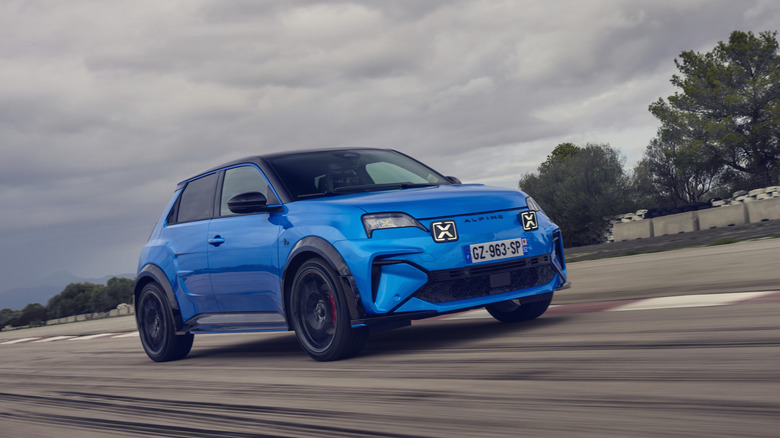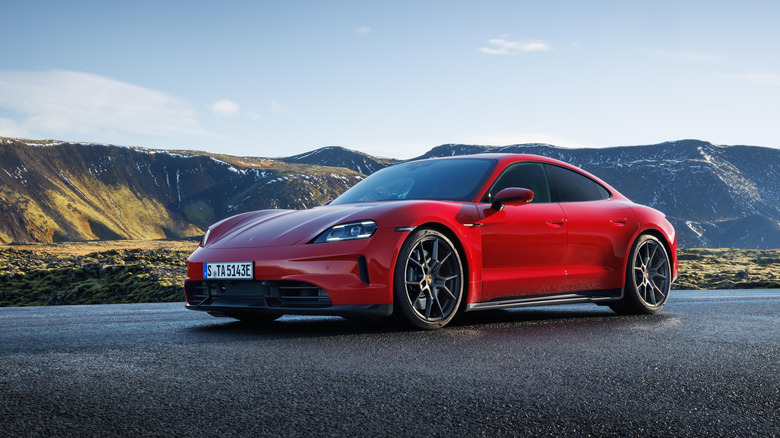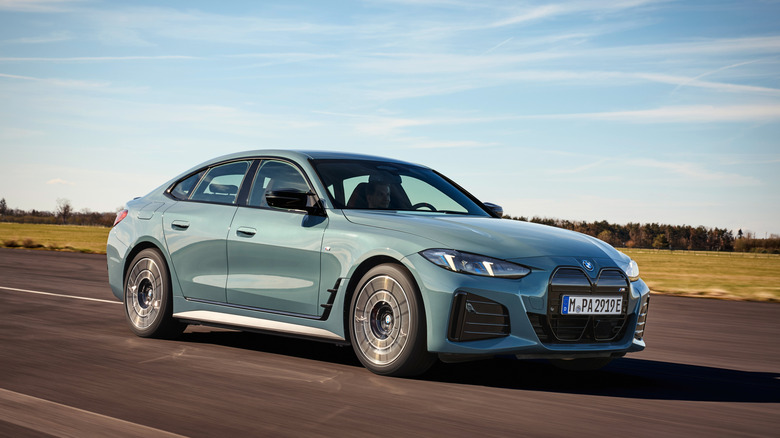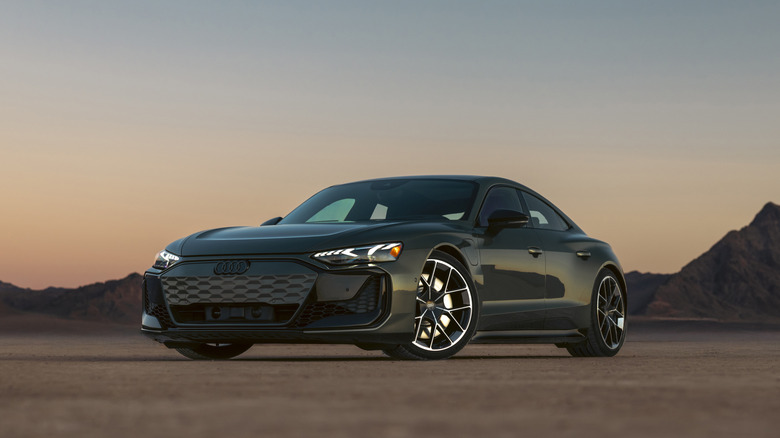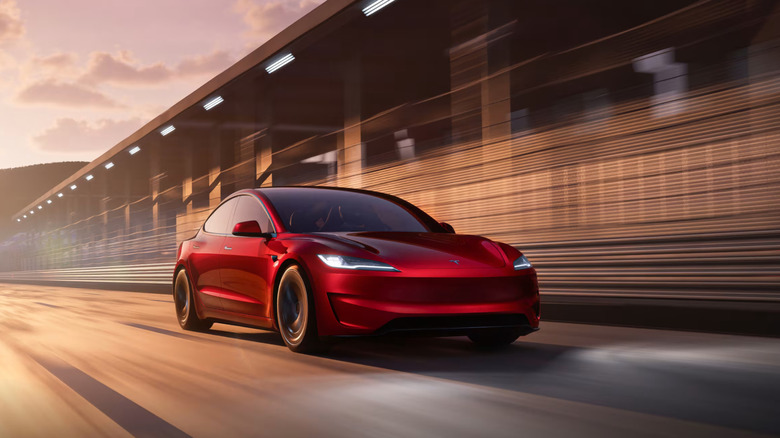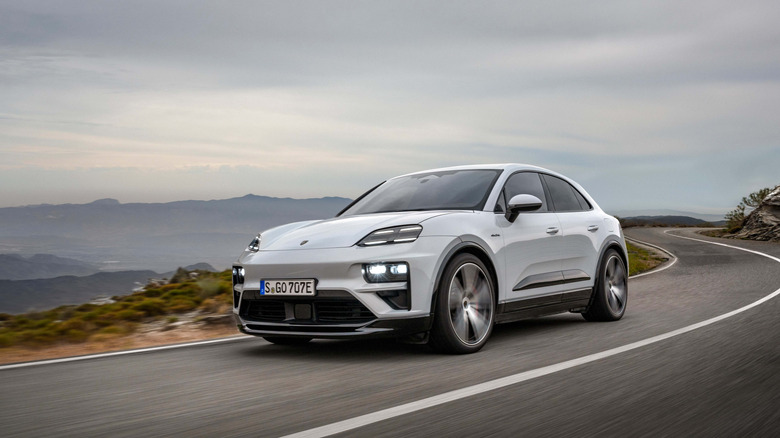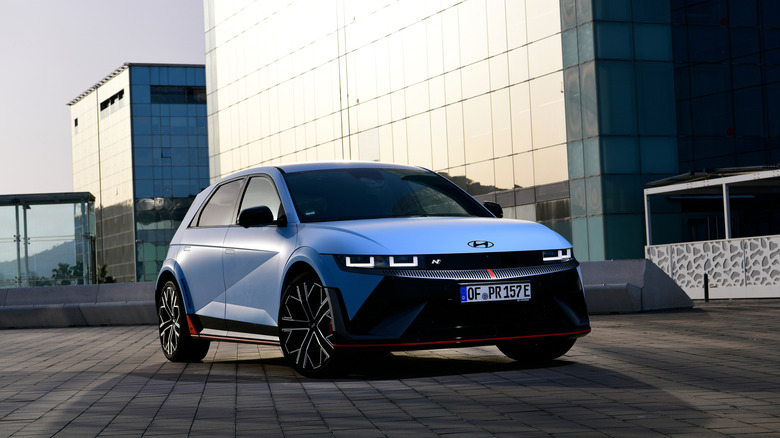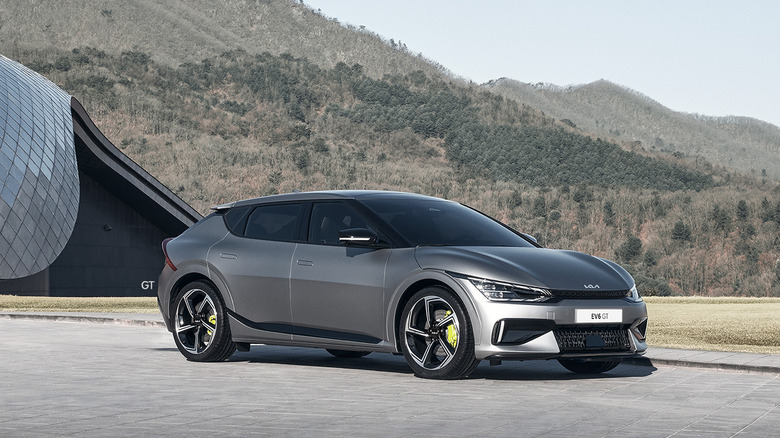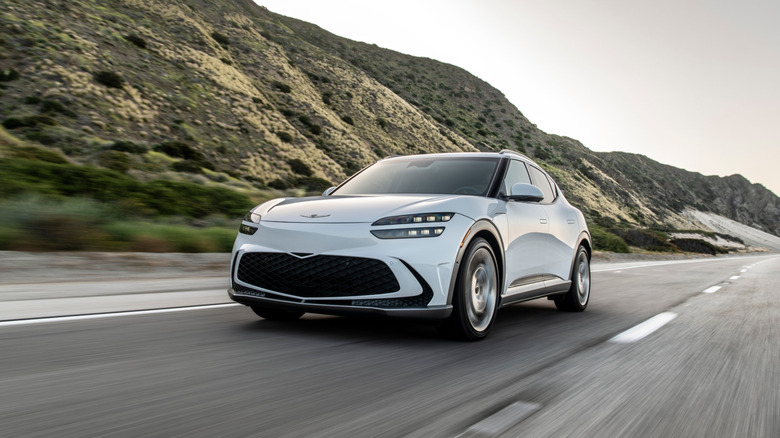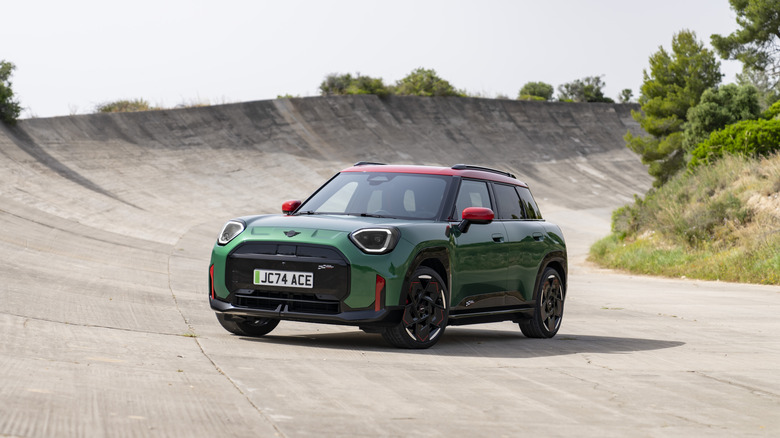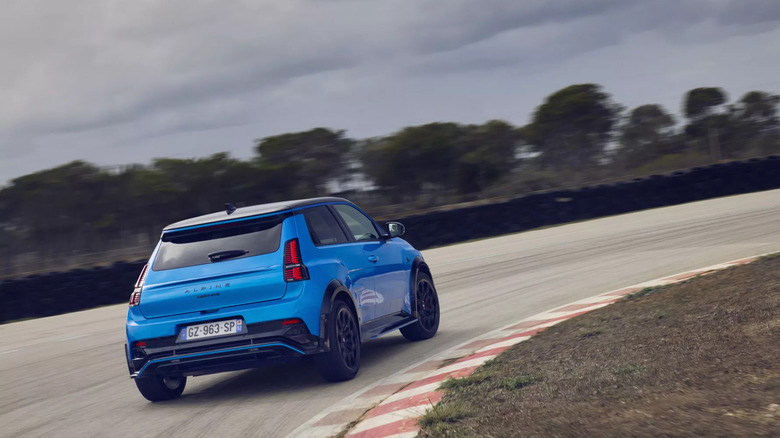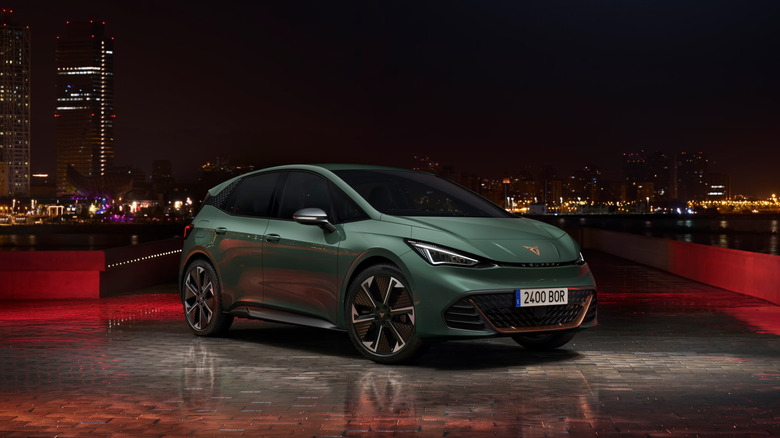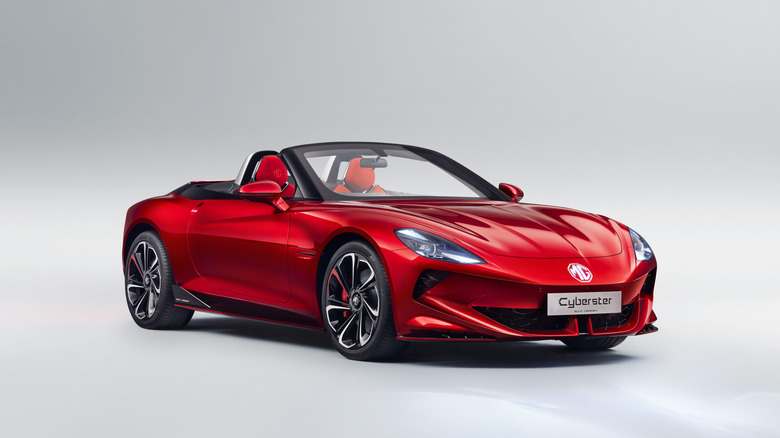12 Electric Cars That Are Fun To Drive
Looking at the current crop of electric cars, one thing immediately stands out — they are incredibly quick off the line. We'll probably never see a gas-powered car be quicker than an EV; The Rimac Nevera hypercar, for example, reaches 62 mph (100 km/h) in a mind-numbing 1.81 seconds. Even a 2,000+ hp gas car will struggle to reach that. Unlike internal-combustion engines, electric motors provide instant torque and response, and EVs usually have no transmissions that would cut power.
Despite that, enthusiasts didn't exactly race to the dealerships to buy the quickest EV. At the end of the day, an enthusiast car needs to be fun to drive. Accelerating quickly is part of that equation, but engine noise and gear changes also play a role. Some EVs try to mimic these synthetically.
Unfortunately, automakers can't emulate the lightness of a gas-powered sports car because batteries are simply too heavy. Still, with electric motors being so responsive, engineers can use them to tighten up the handling and enhance the driving experience. Contrary to popular opinion, many modern electric cars are fun to drive, and in this article, you'll meet the most enjoyable of the crop.
2025 Porsche Taycan GTS
The Porsche Taycan Turbo S is one of the fastest EVs on sale, sprinting to 60 mph in an astonishing 2.3 seconds, thanks to a 938-hp dual-motor drivetrain. Yet, we reckon you can have as engaging an experience with the much cheaper Taycan GTS. No worries — it's still mega-quick, hitting the 60 mph mark in 3.1 seconds. Or, faster than an Aston Martin V12 Vantage (3.4 seconds). These numbers are hardly surprising. The Taycan GTS has 690 hp and 582 lb-ft of torque with overboost enabled, providing you with instant acceleration out of every corner. Heck, there is even a push-to-pass button that gives you all the beans whenever you need them.
Still, it's the handling that has always differentiated the Taycan from its electric rivals. The GTS model, in particular, gets the enhancements from the Taycan Turbo S for better driving dynamics, including adaptive air suspension, a more rigid rear stabilizer, and Porsche Torque Vectoring Plus with rear differential lock. All work in unison to sharpen the handling. In true Porsche fashion, the steering is also very responsive and communicative, unlike the lifeless racks of other EVs. With the optional Porsche Active Ride suspension system, the Taycan GTS stays even flatter in the corners while also delivering an exceptionally smooth ride.
You'll get to enjoy the Taycan GTS for quite a while before the battery drains completely. The 97.0-kWh unit is good for 300+ miles of real-world range. Charging is blistering, too, with the 800V architecture allowing 320 kW, or 10-80% in just 18 minutes.
2025 BMW i4 M50 xDrive
The Taycan GTS is the pinnacle in EV driving dynamics, but at $135,000+, it's too expensive for most. Fortunately, its Bavarian counterpart cooked up a performance EV that's nearly as quick and engaging, at half the price ($71,875). BMW's i4 M50 xDrive brings M Performance magic into the world of electrons, with a potent 536-hp dual-motor powertrain bringing the sleek sedan to 60 mph in 3.7 seconds. Yes, not massively quick by today's standards, but come on — that's still a blistering pace.
Crucially, the i4 M50 justifies the M badge in the corners, too. Colleague Chris Davies was impressed with the BMW i40 M50's engaging handling, claiming that it handled corners with poise and precision. Sure, it's still not as entertaining as an M3, but you can say the same for most other cars. As far as EVs go, the i40 M50 is near the top in the driving experience department.
Thanks to the excellent adaptive suspension, the i40 M50 can be smooth and refined, too. Put it in comfort mode, and you can enjoy a silent, plush ride. BMW also does a tremendous job with interiors lately — the i40 M50 looks and feels premium inside. Add to that a decently roomy and practical layout, and BMW's performance EV turns into a great daily driver proposition.
Unfortunately, it's not all sunshine and rainbows. With a 227-mile official EPA range, the i40 M50 requires more frequent stops. The 83.4-kWh battery doesn't charge as quickly, either, topping out at 200 kW.
2025 Audi RS e-tron GT Performance
Audi's answer to the current crop of electric performance sedans is the RS e-tron GT. It's mostly the same car underneath as the Taycan, while being way cheaper, with the most powerful Performance variant undercutting the similar Taycan Turbo S by tens of thousands of dollars, depending on optioning.
You still get a lot of pizzaz in the RS e-tron GT Performance. The dual-motor powertrain produces a staggering 912 hp, bringing the sleek coupe-sedan to 60 in just 2.4 seconds. The performance model also comes equipped with an air-spring suspension and has been upgraded to a two-chamber, two-valve setup for 2025. You can even get the active dampers from Porsche, which keep the RS e-tron GT Performance flat in the corners.
We got the chance to test the Audi RS e-tron GT in 2021, before the latest upgrade. Even with 637 hp on tap, the pre-upgrade version felt blisteringly quick, so we could only imagine how frightening the 2025 model is. Audi's flagship EV was also fun to throw around corners, with the active suspension probably improving matters even further.
Audi upgraded another crucial aspect — the battery capacity jumped to 97 kWh, allowing an EPA-rated range of 278 to 300 miles. The new battery can also be charged at up to 320 kW, just like the Taycan.
2025 Tesla Model 3 Performance
Tesla was the OG in the performance sedan game with the Model S. Still, we reckon the Model 3 is a more entertaining car to drive. The latest 2024 upgrades to the Performance variant made it even quicker in a straight line, with a 510-hp dual-motor powertrain delivering a 0-60 time of 2.9 seconds. The 163-mph top speed is impressive, too. The Model 3 Performance also has an impressive 298-mile EPA range and can charge quickly on Tesla's Supercharger network.
But the Model 3 Performance didn't deserve to be on its list just because of the performance figures. In fact, any Tesla is quick in a straight line. The upgraded 2024 model brought a sportier suspension with a 0.4-inch lower ground clearance, along with special modes that allow the driver to choose between understeer, oversteer, or neutral handling. Yup, it's all made through algorithms, but it works. The result is a significantly more engaging EV than the pre-facelift model. Maybe not as fun to drive as a Taycan, or even an i4 M50, but easily one of the best performance cars starting at $56,630. With incentives, it would drop below $50k!
The best part — the Model 3 is a very usable daily driver. The cabin is spacious, both for passengers and cargo. It feels airy, too, thanks to the generous greenhouse area with huge side windows and panoramic glass roof.
2025 Porsche Macan 4S EV
With Tesla stagnating recently, Porsche is the company that started pushing the EV envelope, and no vehicle makes that more evident than the Macan EV. Sitting alongside the regular gas-powered Macan, the brand-new model is Porsche's first EV on the advanced Premium Platform Electric (PPE) with 800V architecture. This allows crazy-fast charging speeds (10-80% in 21 minutes) on 800V chargers, and speedy charging on 400V chargers, with a switch in the Macan EV splitting the battery into two 400V units. Since it's an SUV, the Macan EV is decently practical, too, while its 288-mile range allows road trips.
Still, being a Porsche, the Macan EV is all about the driving experience. The Stuttgart-based automaker equips all models with adaptive air suspension, while the 4S and Turbo models get rear torque vectoring. Rear-wheel steering is an optional upgrade that should make the handling more agile. Even without it, the 2025 Porsche Macan 4S electric can put a big smile on your face, with excellent driving dynamics and a punchy dual-motor setup. Yes, the 630-hp Turbo variant is quicker, but the 509-hp 4S model isn't too far behind. It hits 60 in just 3.9 seconds, so it's quite rapid for a family-oriented SUV that's also quiet and refined. Starting at $84,900, the Macan 4S EV is expensive, but the Porsche badge carries quite a lot of weight.
2025 Hyundai Ioniq 5 N
The Ioniq 5 N is perhaps the first truly exciting EV to drive, aimed directly at automotive enthusiasts. It's a supremely practical crossover with plenty of space for passengers and cargo, just like the regular model. Yet, it also oozes boy racer, rally hot hatch vibes. Yes, quite a lot of attributes, but they are necessary to describe this almost foolish EV performance concoction.
See, this retro-futuristic Hyundai can beat a supercar on the drag strip. Its dual-motor drivetrain produces up to 641 hp (with N Grin Boost enabled), bringing the crossover to 60 in a blistering 3.3 seconds. Yet, it also has the chassis to compete in the corners. The rear-biased AWD system gives it playfulness you wouldn't expect from an EV — you can drift in this thing! It's also very grippy and capable when you need it, courtesy of the performance-oriented Pirelli P Zero tires.
Still, nothing screams fun louder than the fake transmission shifts and engine sounds. Those transmission shifts are very believable — it feels almost as if you used Hyundai's dual-clutch. Yet, there is no gearbox — everything is synthetic. Still, there is no denying that it adds to the experience. As for the sounds, they do get old quickly, but we must give Hyundai props for spicing things up.
Unfortunately, the Ioniq 5 N's range suffers significantly. Its smaller 84-kWh battery is only enough for a 221-mile EPA rating and perhaps even less in real-world conditions. But hey, at least it charges up to 238 kW.
2025 Kia EV6 GT
Does the Ioniq 5 N sound enticing to you, but you aren't a fan of its Lancia Delta Integrale aesthetics? Hyundai's sister company might have the answer. It's called the EV6 GT, and underneath, it's mostly the same car as the Ioniq 5 N. Yet, it looks way more voluptuous and aggressive. Instead of the sharp, origami style of its sibling, it employs a more sculpted, fluid aesthetic.
The EV6 GT has the same 641-hp dual-motor powertrain, though, which brings it to 60 in 3.4 seconds — that's supercar territory. Thanks to the adaptive dampers and high-performance summer tires, the EV6 GT also handles corners neatly. It's engaging, though it lacks the fake transmission shifts and noises from its Hyundai sibling.
Regrettably, just like the Ioniq 5 N, the limited range also makes the Kia EV6 GT a tough sell. Utilizing the same 84-kWh battery, Kia's performance EV is EPA rated for 231 miles on a charge. That's a small jump over the 2024 model with a 77.4-kWh battery, but still very restrictive. Of course, the range will fall significantly under the EPA rating if your intent is to have fun. At least the Kia EV6 GT is slightly cheaper than the Ioniq 5 N ($65,275 vs. $67,675), though it also lacks the fake-internal-combustion drama.
2025 Genesis GV60 Performance
The Ioniq 5 N and EV6 GT are excellent performance EVs, though perhaps too expensive for the badge and cabin materials. But, hey, Hyundai thought of that and introduced a more luxurious version under the Genesis brand. Yes, it shares the architecture with its Hyundai and Kia siblings, but the Genesis GV60 gives lessons in electric luxury with plusher materials and a superior interior finish. It looks the part, too, with a coupe-like body reminiscent of the BMW X6 and Genesis' recognizable front end.
Although geared towards the luxury crowd, there is a Performance variant of the GV60 available. Unlike its siblings, the dual-motor powertrain here makes 483 hp with Boost Mode engaged. Still, with a 4-second 0-60 sprint, the GV60 Performance is more than capable enough in a straight line. Moreover, with the recently announced GV60 Magma concept, Genesis announced it's working on a more hardcore version, which would most probably borrow the 641-hp drivetrain from its siblings.
Crucially, the GV60 Performance comes standard with an adaptive suspension and electronic locking rear differential, giving it more agile, responsive handling. Of course, the Ioniq 5 N gimmicks weren't transferred into the luxurious surroundings, but even without them, the GV60 Performance can put a smile on your face.
A slightly annoying thing about Genesis' electric crossover is that it was still not upgraded to the larger 84-kWh battery. As it stands, its 77.4 kWh battery pack is only good for a 235-mile EPA-rated range.
2025 Mini John Cooper Works Aceman Sport
Mini announced the Aceman last year, giving us hints of its all-electric future. At only 160.24 inches long, this subcompact crossover will slot below the Countryman Electric in the range. Although not yet offered in the U.S., the Aceman has been on sale in Europe for a while, blending Mini's modern styling approach with an advanced electric drivetrain.
Still, looking at the numbers alone, it's hard to be impressed by the Aceman. The most powerful John Cooper Aceman Sport has only one 258-hp motor on the front axle, and a tiny 49.2-kWh battery. That's only enough for a 0-62 mph (0-100 km/h) acceleration of 6.4 seconds, and a 214-mile range on the generous WLTP cycle. Expect a sub-200-mile EPA range if the Aceman arrives in America.
But you know what? The small battery also makes the Aceman lighter than most modern EVs, weighing in at just north of 4,000 pounds. That, along with Mini's expertise in making excellent front-wheel-drive hot hatches, makes the Aceman quite an agile EV. Heck, Mini even employed a Go-Kart Mode that amps up the responsiveness to eleven, turning the Aceman into a fun-to-drive machine on tight, twisty roads.
2025 Alpine A290
The fact that straight-line speed doesn't always equal fun-to-drive is best displayed in Alpine's electric hot hatch, the A290. Yup, this is the same EV as the gorgeous Renault 5 but improved by the French automaker's performance division.
Just like the JCW Aceman Sport, the A290 doesn't play the numbers game. The entry-level GT model has one 178-hp motor on the front axle, with the GTS bumping the figure to 217 hp. Americans will probably wonder how this even qualifies as a performance car, but a 0-62 mph time of 6.4 seconds is still quick enough on European twisties. It also means you can drive the A290 at 100% on public roads, without losing your license.
Alpine's improvements also make the A290 a very nimble cornering tool. It's only front-wheel drive, meaning drifting shenanigans are out of the question, but you can still lift off the throttle to induce oversteer, similar to France's legendary hot hatches, like the Renault 5 Turbo and Peugeot 205 GTI.
Thanks to the low curb weight of 3,260 pounds, the Alpine A290 also feels lighter on its feet than an EV, so it's far more engaging in the corners. This means it also has a smaller 52-kWh battery, which is only good for a 226-mile WLTP range (∼190-mile EPA). Still, the A290 is a tiny urban dweller, so the short-ish range is less of an issue.
2025 Cupra Born VZ
The Cupra Born VZ is another handsome performance EV you can't get in the U.S. Well, at least not yet — the VW Group performance brand should enter the U.S. market by 2030. The Born VZ will probably be replaced by a successor by that point, but even now, it's an attractive proposition.
Based on the VW ID.3, this Spanish model tries to blend hot hatch thrills with the power of electrons. Unlike its rivals, though, the Born VZ employs a 322-hp rear motor. So, it's perhaps not a classic European hot hatch, but who cares about phraseology when you can drift out of a corner? The Born VZ feels agile and eager to turn. It doesn't understeer much, if you will. You know, like a real driver's car.
It's also faster than the current electric hot hatch norm, reaching 62 mph (100 km/h) in 5.6 seconds. Unsurprisingly, since VZ stands for 'veloz', or 'fast' in Spanish. Maybe Cupra should've also added 'batería grande' to the name, because the Born VZ packs a sizeable 79-kWh battery, good for a WLTP-rated range of 366 miles. That's an excellent range for a performance EV and probably a consequence of the rear-motor configuration.
2025 MG Cyberster
Ever since the first-gen Tesla Roadster was discontinued in 2012, we've waited for an attractive open-top electric car. Still, developing new EV platforms is costly, and automakers certainly won't rush to make small-volume roadsters that will never be profitable.
Yet, in 2023, Chinese automaker MG Motor made headlines with the Cyberster. A two-seat roadster that runs only on electrons, the Cyberster tries to capture the allure of the MG MGB roadster, but with a contemporary approach. Looking at it, the Cyberster certainly looks the part, with a sleek, curvaceous body and spot-on proportions.
It's quick, too — not that you expected anything less from an all-electric sports car. The entry-level model has a single rear motor producing 335 hp, enough for a 0-62 mph sprint of 5.0 seconds. For those who want a more neck-snapping acceleration, the 503-hp dual-motor version needs only 3.2 seconds.
Still, the RWD model is probably the more engaging one. It has a lighter curb weight to the tune of a 220-pound savings. Moreover, removing the front motor means less weight on the front axle, aiding with handling. Overall, the Cyberster is well-regarded for its driving dynamics, especially considering it's still a heavy car. Yes, it won't replace a Porsche 718 Boxster anytime soon, but it should still put a smile on your face. Still, we are happy that it exists. For overseas buyers, that is, because the Cyberster is among the dozen cool Chinese cars you'll wish were sold in the U.S.
